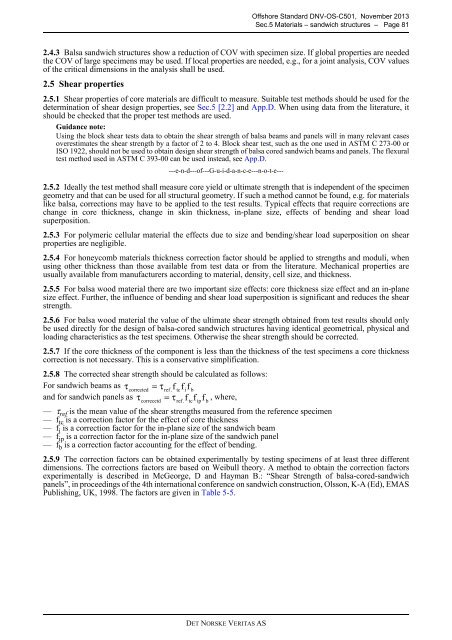OS-C501
Create successful ePaper yourself
Turn your PDF publications into a flip-book with our unique Google optimized e-Paper software.
Offshore Standard DNV-<strong>OS</strong>-<strong>C501</strong>, November 2013<br />
Sec.5 Materials – sandwich structures – Page 81<br />
2.4.3 Balsa sandwich structures show a reduction of COV with specimen size. If global properties are needed<br />
the COV of large specimens may be used. If local properties are needed, e.g., for a joint analysis, COV values<br />
of the critical dimensions in the analysis shall be used.<br />
2.5 Shear properties<br />
2.5.1 Shear properties of core materials are difficult to measure. Suitable test methods should be used for the<br />
determination of shear design properties, see Sec.5 [2.2] and App.D. When using data from the literature, it<br />
should be checked that the proper test methods are used.<br />
Guidance note:<br />
Using the block shear tests data to obtain the shear strength of balsa beams and panels will in many relevant cases<br />
overestimates the shear strength by a factor of 2 to 4. Block shear test, such as the one used in ASTM C 273-00 or<br />
ISO 1922, should not be used to obtain design shear strength of balsa cored sandwich beams and panels. The flexural<br />
test method used in ASTM C 393-00 can be used instead, see App.D.<br />
---e-n-d---of---G-u-i-d-a-n-c-e---n-o-t-e---<br />
2.5.2 Ideally the test method shall measure core yield or ultimate strength that is independent of the specimen<br />
geometry and that can be used for all structural geometry. If such a method cannot be found, e.g. for materials<br />
like balsa, corrections may have to be applied to the test results. Typical effects that require corrections are<br />
change in core thickness, change in skin thickness, in-plane size, effects of bending and shear load<br />
superposition.<br />
2.5.3 For polymeric cellular material the effects due to size and bending/shear load superposition on shear<br />
properties are negligible.<br />
2.5.4 For honeycomb materials thickness correction factor should be applied to strengths and moduli, when<br />
using other thickness than those available from test data or from the literature. Mechanical properties are<br />
usually available from manufacturers according to material, density, cell size, and thickness.<br />
2.5.5 For balsa wood material there are two important size effects: core thickness size effect and an in-plane<br />
size effect. Further, the influence of bending and shear load superposition is significant and reduces the shear<br />
strength.<br />
2.5.6 For balsa wood material the value of the ultimate shear strength obtained from test results should only<br />
be used directly for the design of balsa-cored sandwich structures having identical geometrical, physical and<br />
loading characteristics as the test specimens. Otherwise the shear strength should be corrected.<br />
2.5.7 If the core thickness of the component is less than the thickness of the test specimens a core thickness<br />
correction is not necessary. This is a conservative simplification.<br />
2.5.8 The corrected shear strength should be calculated as follows:<br />
For sandwich beams as τcorrected<br />
= τref .<br />
f<br />
tcf<br />
if<br />
b<br />
and for sandwich panels as τ = τ f f f , where,<br />
correcetd<br />
ref .<br />
— τ ref is the mean value of the shear strengths measured from the reference specimen<br />
— f tc is a correction factor for the effect of core thickness<br />
— f i is a correction factor for the in-plane size of the sandwich beam<br />
— f ip is a correction factor for the in-plane size of the sandwich panel<br />
— f b is a correction factor accounting for the effect of bending.<br />
tc<br />
ip<br />
b<br />
2.5.9 The correction factors can be obtained experimentally by testing specimens of at least three different<br />
dimensions. The corrections factors are based on Weibull theory. A method to obtain the correction factors<br />
experimentally is described in McGeorge, D and Hayman B.: “Shear Strength of balsa-cored-sandwich<br />
panels”, in proceedings of the 4th international conference on sandwich construction, Olsson, K-A (Ed), EMAS<br />
Publishing, UK, 1998. The factors are given in Table 5-5.<br />
DET NORSKE VERITAS AS



